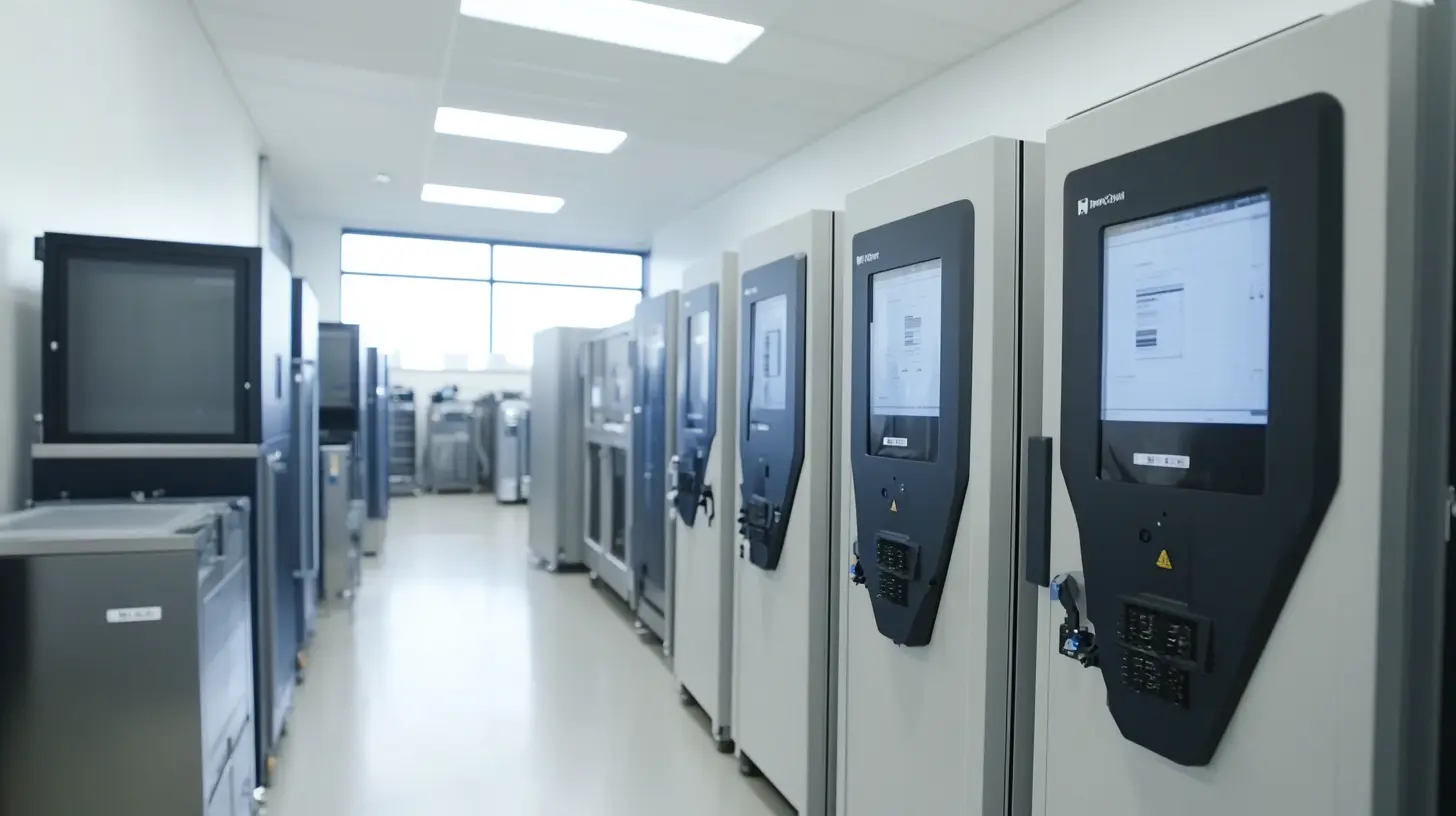Leave Your Message
Solid-state batteries have attracted a lot of attention as they become an alternative to conventional lithium-ion batteries due to the rising demand for cleaner and more efficient energy storage solutions. These new power supply systems are characterized by several advantages, including higher energy density, greater safety, and an extended lifespan. However, manufacturing solid-state battery machines presents its own challenges that must be addressed by best practices for ensuring optimum performance and dependability throughout its lifecycle. This blog will present the ultimate seven best practices for solid-state battery machine manufacturing, thus giving insights for various companies interested in enhancing their production efficiencies.
Dongguan Wangsheng Automation Equipment Co., Ltd prides itself on understanding the relevant developing enter into advanced manufacturing techniques. It being a high-tech enterprise that focuses primarily on laboratory equipment lines for Li-ion and Sodium-ion batteries is committed to providing top-grade automation solutions keeping an eye on the advent changes in the battery industry. Its advanced mold processing workshop along with a diverse range of equipment consumables empower manufacturers to optimize their solid-state battery machine operations and achieve unparalleled results. Let us join on the journey of fundamental practice transformation for one's solid-state battery manufacturing capabilities.

Solid-state batteries are a genuine breakthrough in energy storage solutions for providing safety and performance levels far superior to lithium-ion batteries. At the heart of the development of solid-state batteries lies the use of solid electrolytes instead of conventional liquid or gel electrolytes. This basic change allows for a high energy density that leads to longer battery life and faster charging while minimizing potential hazards involving leakage and fire. To grasp the fundamental principles governing solid-state batteries, it is paramount to understand their architecture and the materials involved in their construction. The solid electrolyte governs the flow of ions between the anode and the cathode, promoting efficient energy flow. This better ionic conductivity yields better performance from the battery itself. The most important materials, sulfides, oxides, and polymers, define the character of the solid electrolyte, affecting not only energy density but thermal stability and finally the scale-up of production techniques. Production goes beyond solid-state battery-making: it is both precise and innovative. Combining methods like thin-film deposition and interface engineering ensures seamless interaction between all components for maximal efficiency. By implementing best practices in the setting up of production lines and strict adherence to quality control, manufacturers can take solid-state technology to its full potential and the consequent widespread acceptance in electric vehicles, portable electronics, and renewable energy systems.

The choice of key materials substantially influences the performance and production efficiency of solid-state battery fabrication. With this in mind, the innovation surrounding solid-state batteries comprises the use of materials that would improve energy density and production flow. For instance, manufacturers could elect high-conductivity electrolytes, either sulfide-based or oxide-based, to improve ion transport for faster production cycles with lesser defect types.
The selection of electrodes directly affects solid-state battery production efficiency. The introduction of advanced materials like lithium metal or composite electrodes will enhance charge capacity and drastically reduce the weight of the final product. Not only does this work well in the end performance of the battery, it also works in favor of reducing time and costs in assembly. Compatibility between these electrodes and the electrolytes selected ensures a productive and accessible integration process with less room for manufacturing-related complications.
The advanced materials need to be complemented by advanced methods. Precision coating and high-energy compaction are some manufacturing tools that can dramatically enhance the uniformity and consistency of the material layers for the desired battery performance. With their focus on the interface, the combined approach of optimizing both material choice and manufacturing will expand the horizons of solid-state battery technology and will entail avenues for future innovations.

The emerging technology of solid-state batteries is attracting interest not only within the field of battery development but also from many other industries. Manufacturing equipment for advanced solid-state battery production is crucial to this new technology. Advanced precision fabrication machinery, automated assembly lines, and advanced testing equipment are critical components of the complete solid-state battery manufacturing production facility. These production facilities are indispensable in enabling production processes to live up to the rigorous quality and safety standards necessary to realize the potential of solid-state batteries.
The advancements in the recent times have also been accompanied by investments and initiatives in research and development that accelerate commercialization of the technology in viable applications. The creation of an entire supply chain from raw materials to final delivery, for instance, is a core activity of several organizations that developed action plan components to further this cause. The innovation in solid-state batteries does not solely lie in the chemical formulation but extends to offer machinery that enables their production. Manufacturers need to invest in high-end equipment to meet the increasing demand from consumers.
Observing change in the landscape, one would realize the strength of manufacturing as necessary inputs. Added to cutting-edge technology will be methods to integrate systems in delivering effective mass manufacture of solid-state batteries. As stakeholder excitement continues to build around the technology, they are bound to prioritize investments in superior machining and supplier relations as they tackle the issues surrounding cost, scalability, and performance reliability in a highly competitive market.

It is vital to build a scalable manufacturing process for solid-state batteries with a view to wider energy density and performance along the demand line. This has recently been moved to the emerging super battery technologies, tantalizingly introduced by the research efforts of specialists like Associate Professor Bao Yinhua from the Institute of Mechanics and Engineering Science. Collaborating with a team of experts, Bao's group has made remarkable strides in developing flexible lithium-ion batteries that stretch up to 5000%. Thus, these futuristic creations are not only suitable in the context of the burgeoning needs of wearable electronic devices but also capable of being adapted to scalable production methods in the battery manufacturing industry.
When the solid-state battery market gets traction, it becomes vital to include best practices in the manufacturing process. For example, the installation of advanced machines like Dürr's new GigaCoater for dual-sided coating is exemplary of how technology can be brought to bear on production improvement. By focusing on the design of solid-state battery-from material selection to layering techniques-manufacturers now stand to create a much more malleable scaling process. Added to this is the huge AI-driven research initiatives on which the possibilities of rapid implementations in this technological domain would be founded, necessitating the formulation of a scalable manufacturing strategy for competitive growth in this market.
This is indeed where all roads will lead with respect to the change in battery technology; solid-state batteries, these days, are the most hotly debated batteries. Companies, including FactorialEnergy and a couple of others, are working hard to develop their own technologies for batteries, and nothing better but these manufacturing best practices will accelerate all kinds of batteries to meet future energy storage requirements for various sectors.
Quality control is very important when manufacturing solid-state batteries; it calls for precision in engineering for safety and performance with a regard for lifetime-consideration. Several critical steps are followed in the solid-state battery manufacturing process, starting from material selection to the assembly of cell stacks. Each of these steps must be stringently tested to identify defects and maintain the highest standards. Real-time monitoring systems work wonders, enhancing the quality control so that manufacturers can detect and rectify defects during production.
Secondly, standard operating procedures go a long way in proving the integrity of materials and components. For example, electrolytes interface regularly with checks on the cathode structures to guarantee conductivity and stability. High-resolution imaging techniques can even identify tiny defects capable of precipitating catastrophic failures thereby asserting the reliability of batteries.
Supplier collaboration is another important element in the quality control of solid-state batteries. With good joint ventures and strict adherence to material specifications, manufacturers can minimize variability and improve product quality. Ongoing training and education of all personnel that influence production will enhance a quality culture such that all involved take responsibility for maintaining high standards at all times.
Amidst all changes and constant progress in solid-state battery manufacturing, innovation in automation has been established as an important benchmark for the improvement of production processes and product-quality delivery. A recent report from the International Energy Agency (IEA) reveals that the global electric vehicle market would surpass 145 million units by 2030, implying an urgent need for advanced battery technologies for increasing customer consumption. Automating processes such as robotics and artificial intelligence (AI) has streamlined the production process in solid-state battery performances, reducing human errors, and increasing the output of batteries produced.
The automation of variance stages in a solid-state battery line has anchored with robotics that use automated systems, which are faster and more precise in the assembling of intricate battery components. In a report by McKinsey & Company, automation increases productivity with up to 30 percentage points, thus reducing costs to a very significant low while keeping standards high in battery performance and safety. Furthermore, the adoption of AI in quality control systems is imperative, as it could support real-time monitoring and predictive provisions so that manufacturers may pre-emptively discover and correct potential problems before they lead to actual product failures.
Smart manufacturing technologies such as IoT also sharpen the capacities of solid-state battery factories. For example, with IoT sensors in place, a manufacturer can glean very useful information on equipment performance and process conditions, thus making better-informed decisions and optimised operations. A report of IDTechEx estimated the total market for solid-state batteries to rise from $1 billion in 2020 to over $25 billion by 2030; huge investments and advances due to automation will trigger this growth. With this, the improvement would not only involve manufacturing efficiency but also encourage the postmen adoption of solid-state batteries beyond electric vehicles into consumer electronics and renewable energy storage systems.
The sustainability of solid-state batteries is becoming more and more relevant as the market grows for efficient and environmentally friendly solutions for energy. Such batteries are believed to be higher in energy density and exhibit improved safety profiles as compared to conventional lithium-ion batteries. Thus, it can be said that the manufacturing processes of such batteries must be based on sustainable practices for minimizing environmental impacts.
One of the main best practices for sustainable manufacturing is using eco-friendly materials. The manufacturers should obtain the raw materials from sustainable suppliers and apply recycling methods to considerably reduce their carbon footprints. The incorporation of renewable power sources such as solar or wind, while employing one's strategies to manufacture, should ultimately lead to reduced greenhouse gas emissions and simultaneously enhance a company as a visionary environmental stewardship business.
Ultimately, the judicious harnessing of production strategies contributes to reinforced sustainability. Lean manufacturing practices may reduce waste while simultaneously improving the efficacy of resource consumption. Automated systems and advanced robotics streamline operations in ensuring minimum energy consumption with good quality of produced final products. Furthermore, developing the circular economy model-that is, putting in place inseparable repeatability of materials for their end use and reprocessing for such end use-should generate a more sustainable battery production process and also include reducing electronic waste.
The solid-state battery manufacturing sector is right on the edge of a revolutionary change due to both technological advancements and increasing demand for high-performance energy storage solutions. Therefore, these manufacturers are deep into process optimization, and a strong set of trends is expected to shape the industry. One of the foremost trends will be automation and robotics in the manufacturing process. This will enhance efficiency and precision and, even more importantly, eliminate contamination risk, which is critical in solid-state battery production.
Another emerging trend is the development of new materials that can make a world of difference in the performance of solid-state batteries. Researchers are pursuing the development of advanced electrolyte materials that apply greater ionic conductivity and enhanced thermal stability. This line of research has moved beyond conventional substrate materials to examine solid-state electrolytes that offer fast charge time and long service life. Together with ongoing innovations in the manufacturing process such as roll-to-roll and advanced layering methods, these developments herald a brave step toward mass production opportunities.
Sustainability factor considerations are also nowadays gaining acceptance as major footprints in the solid-state battery manufacturing practices. In line with this, there are organized efforts to adopt greener production methods with low waste and energy consumption in response to the growing trend of manufacturing solid-state batteries. Such transition is bound with the sustainability goals set at the international level as well as the growing market population addressing environmental concerns regarding battery technologies. The overall outlook of solid-state battery manufacturing lies thus in an exciting arena of hope that could reshape energy storage corridors on various fronts.
Quality control is crucial in solid-state battery production to ensure safety, performance, and longevity. Rigorous testing and monitoring throughout the manufacturing process help identify defects and maintain high standards.
Standardized testing procedures help verify the integrity of materials and components, ensuring optimal conductivity and stability, particularly in electrolyte interfaces and cathode structures.
Manufacturers can enhance quality control by implementing real-time monitoring systems, utilizing advanced imaging technologies to detect microscopic flaws, and collaborating closely with suppliers to adhere to strict material specifications.
Important sustainability practices include using eco-friendly materials, sourcing from sustainable suppliers, integrating renewable energy sources, and optimizing production techniques to reduce waste and improve resource efficiency.
Automation and robotics improve efficiency, precision, and reduce contamination risks in the manufacturing process, which is crucial for the high-quality production of solid-state batteries.
Future trends include the development of new materials for better performance, advancements in manufacturing processes such as roll-to-roll techniques, increased automation, and a focus on sustainability to minimize waste and energy consumption.

